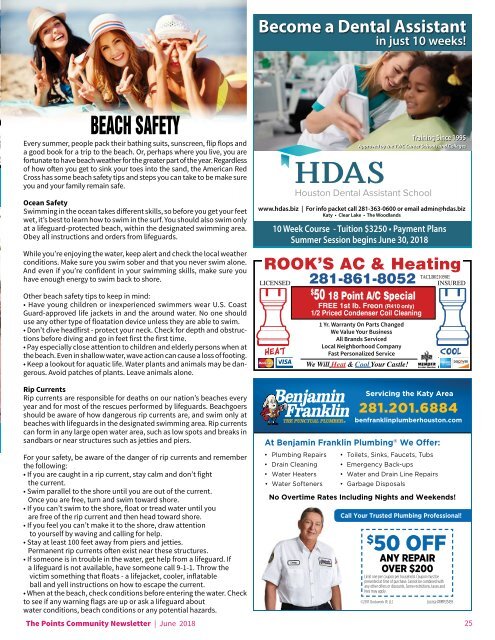The Points June 2018
Create successful ePaper yourself
Turn your PDF publications into a flip-book with our unique Google optimized e-Paper software.
Become a Dental Assistant<br />
in just 10 weeks!<br />
BEACH SAFETY<br />
Every summer, people pack their bathing suits, sunscreen, flip flops and<br />
a good book for a trip to the beach. Or, perhaps where you live, you are<br />
fortunate to have beach weather for the greater part of the year. Regardless<br />
of how often you get to sink your toes into the sand, the American Red<br />
Cross has some beach safety tips and steps you can take to be make sure<br />
you and your family remain safe.<br />
Ocean Safety<br />
Swimming in the ocean takes different skills, so before you get your feet<br />
wet, it’s best to learn how to swim in the surf. You should also swim only<br />
at a lifeguard-protected beach, within the designated swimming area.<br />
Obey all instructions and orders from lifeguards.<br />
While you’re enjoying the water, keep alert and check the local weather<br />
conditions. Make sure you swim sober and that you never swim alone.<br />
And even if you’re confident in your swimming skills, make sure you<br />
have enough energy to swim back to shore.<br />
Other beach safety tips to keep in mind:<br />
• Have young children or inexperienced swimmers wear U.S. Coast<br />
Guard-approved life jackets in and the around water. No one should<br />
use any other type of floatation device unless they are able to swim.<br />
• Don’t dive headfirst - protect your neck. Check for depth and obstructions<br />
before diving and go in feet first the first time.<br />
• Pay especially close attention to children and elderly persons when at<br />
the beach. Even in shallow water, wave action can cause a loss of footing.<br />
• Keep a lookout for aquatic life. Water plants and animals may be dangerous.<br />
Avoid patches of plants. Leave animals alone.<br />
Training Since 1995<br />
Approved by the TWC Career Schools and Colleges<br />
www.hdas.biz | For info packet call 281-363-0600 or email admin@hdas.biz<br />
Katy • Clear Lake • <strong>The</strong> Woodlands<br />
10 Week Course - Tuition $3250 • Payment Plans<br />
Summer Session begins <strong>June</strong> 30, <strong>2018</strong><br />
LICENSED<br />
HEAT<br />
FREE 1st lb. Freon (R410 only)<br />
1/2 Priced Condenser Coil Cleaning<br />
1 Yr. Warranty On Parts Changed<br />
We Value Your Business<br />
All Brands Serviced<br />
Local Neighborhood Company<br />
Fast Personalized Service<br />
We Will Heat & Cool Your Castle!<br />
TACLB021058E<br />
INSURED<br />
COOL<br />
Rip Currents<br />
Rip currents are responsible for deaths on our nation’s beaches every<br />
year and for most of the rescues performed by lifeguards. Beachgoers<br />
should be aware of how dangerous rip currents are, and swim only at<br />
beaches with lifeguards in the designated swimming area. Rip currents<br />
can form in any large open water area, such as low spots and breaks in<br />
sandbars or near structures such as jetties and piers.<br />
For your safety, be aware of the danger of rip currents and remember<br />
the following:<br />
• If you are caught in a rip current, stay calm and don’t fight<br />
the current.<br />
• Swim parallel to the shore until you are out of the current.<br />
Once you are free, turn and swim toward shore.<br />
• If you can’t swim to the shore, float or tread water until you<br />
are free of the rip current and then head toward shore.<br />
• If you feel you can’t make it to the shore, draw attention<br />
to yourself by waving and calling for help.<br />
• Stay at least 100 feet away from piers and jetties.<br />
Permanent rip currents often exist near these structures.<br />
• If someone is in trouble in the water, get help from a lifeguard. If<br />
a lifeguard is not available, have someone call 9-1-1. Throw the<br />
victim something that floats - a lifejacket, cooler, inflatable<br />
ball and yell instructions on how to escape the current.<br />
• When at the beach, check conditions before entering the water. Check<br />
to see if any warning flags are up or ask a lifeguard about<br />
water conditions, beach conditions or any potential hazards.<br />
<strong>The</strong> <strong>Points</strong> Community Newsletter | <strong>June</strong> <strong>2018</strong><br />
25

















